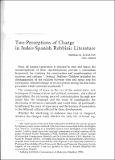Por favor, use este identificador para citar o enlazar a este item:
http://hdl.handle.net/10261/26316COMPARTIR / EXPORTAR:
 SHARE
BASE SHARE
BASE
|
|
| Visualizar otros formatos: MARC | Dublin Core | RDF | ORE | MODS | METS | DIDL | DATACITE | |

| Campo DC | Valor | Lengua/Idioma |
|---|---|---|
| dc.contributor.author | Lehmman, M. B. | - |
| dc.date.accessioned | 2010-07-15T11:02:19Z | - |
| dc.date.available | 2010-07-15T11:02:19Z | - |
| dc.date.issued | 2000 | - |
| dc.identifier.citation | Sefarad: revista de estudios hebraicos, sefardíes y de Oriente Próximo, Año 60, Nº. 1, 1997, pags. 95-122 | en_US |
| dc.identifier.issn | 0037-0894 | - |
| dc.identifier.uri | http://hdl.handle.net/10261/26316 | - |
| dc.description.abstract | [EN] In this article, I analyze the brief references to the invention of the telegraph in Yeuda Papo's Judeo-Spanish version of the Pele Yo'ets and Ben Tsion Rodeti's Sefer Ki Ze Kol ha-Adam, two Judeo-Spanish books of «musar» from the nineteenth century. These rather unlikely references permit us to study perceptions of present, future, and change held by two Sephardic rabbis from the Ottoman Empire in a period of accelerated technological progress and social transformation. Two different attitudes towards change can be described. While Papo's work announces important transformations in the semantics of understanding time, without stepping outside rabbinic tradition itself, Ben Tsion Rodeti denies the very fact of change and affirms that everything that has to be known already is included once and for all in the rabbinic literary tradition. | en_US |
| dc.description.abstract | [ES] En este articulo analizo las refereiicias a la introduccióii del tclégrafo en dos libros de niusar del siglo xix publicados en ladino: el Pele Yo ZS, cuyo versión judeoespañola preparú Yeudá Papo, y el Séfcr Ki ie knl haadain, de Ben-Sigón Binyamin Rodeti. L.os pasajes nos permiten estudiar cómo entendieron estos dos rabinos sefardies el tiempo presente y el futuro, así como los cambios en un periodo de a'vances técnicos y transforniaciones sociales como los que se produjeron en cl Imperio Otomana del siglo xix. Podemos distinguir dos tendencias. Mientras que cl libro de Papo anuncia importantes transformaciones semánticas en el entendimiento del tiempo aunque él mismo nunca sale del márgen de la tradición rabinica-, Ben-Sigón Rodeti descarta que haya cambios g afirma que todo ya se ha dicho en la tradición literaria rabinica y que los tiempos actuales no cuestionan ni pueden cuestionar csta tradición. | en_US |
| dc.format.extent | 1828377 bytes | - |
| dc.format.mimetype | application/pdf | - |
| dc.language.iso | eng | en_US |
| dc.publisher | Consejo Superior de Investigaciones Científicas (España) | en_US |
| dc.rights | openAccess | en_US |
| dc.subject | Judaismo | en_US |
| dc.subject | Análisis | en_US |
| dc.subject | Actitud | en_US |
| dc.subject | Tradiciones | en_US |
| dc.subject | Literatura rabínica | en_US |
| dc.title | Two perceptions of change in Judeo-Spanish rabbinic literature | en_US |
| dc.type | artículo | en_US |
| dc.description.peerreviewed | Peer reviewed | en_US |
| dc.identifier.e-issn | 1988-320X | - |
| dc.type.coar | http://purl.org/coar/resource_type/c_6501 | es_ES |
| item.openairetype | artículo | - |
| item.grantfulltext | open | - |
| item.cerifentitytype | Publications | - |
| item.openairecristype | http://purl.org/coar/resource_type/c_18cf | - |
| item.fulltext | With Fulltext | - |
| item.languageiso639-1 | en | - |
| Aparece en las colecciones: | (CCHS-ILC) Artículos | |
Ficheros en este ítem:
| Fichero | Descripción | Tamaño | Formato | |
|---|---|---|---|---|
| SAD_DIG_ILC_Lehman_Sefarad601.pdf | 1,79 MB | Adobe PDF |  Visualizar/Abrir |
CORE Recommender
Page view(s)
271
checked on 18-abr-2024
Download(s)
156
checked on 18-abr-2024
Google ScholarTM
Check
NOTA: Los ítems de Digital.CSIC están protegidos por copyright, con todos los derechos reservados, a menos que se indique lo contrario.
